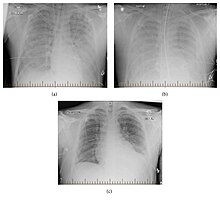
Back متلازمة فيروس هانتا الرئوية Arabic متلازمة فيروس هانتا الرئويه ARZ Síndrome pulmonar por hantavirus Spanish Syndrome pulmonaire à hantavirus French Հանտավիրուսային կարդիոպուլմոնալ համախտանիշ Armenian ハンタウイルス肺症候群 Japanese ହାଣ୍ଟାଭୂତାଣୁ ପଲମୋନାରୀ ସିଣ୍ଡ୍ରୋମ OR Hantawirusowy zespół płucny Polish Síndrome pulmonar por hantavírus Portuguese Хантавирусный кардиопульмональный синдром Russian
| Hantavirus pulmonary syndrome | |
|---|---|
| Other names | Four Corners disease |
 | |
| Progression of hantavirus pulmonary syndrome | |
| Specialty | Pulmonology |
| Symptoms | Fever, cough, shortness of breath, headaches, muscle pains, lethargy, nausea, diarrhea |
| Complications | Respiratory failure, cardiac failure[1] |
| Causes | Hantaviruses spread by rodents |
| Differential diagnosis | Community acquired pneumonia, leptospirosis, tularemia, pneumonic plague[1] |
| Prevention | Rodent control |
| Treatment | Supportive, including mechanical ventilation |
| Medication | None |
| Prognosis | Poor |
| Deaths | 36–40% mortality |
Hantavirus pulmonary syndrome (HPS) is one of two potentially fatal syndromes of zoonotic origin caused by species of hantavirus.[2] These include Black Creek Canal virus (BCCV), New York orthohantavirus (NYV), Monongahela virus (MGLV), Sin Nombre orthohantavirus (SNV), and certain other members of hantavirus genera that are native to the United States and Canada.[3]
Specific rodents are the principal hosts of the hantaviruses including the hispid cotton rat (Sigmodon hispidus) in southern Florida, which is the principal host of Black Creek Canal virus.[4][5] The deer mouse (Peromyscus maniculatus) in Canada and the Western United States is the principal host of Sin Nombre virus.[6][7] The white-footed mouse (Peromyscus leucopus) in the eastern United States is the principal host of New York virus.[8] In South America, the long-tailed mouse (Oligoryzomys longicaudatus) and other species of the genus Oligoryzomys have been documented as the reservoir for Andes virus.[9][10][11]
- ^ a b Cite error: The named reference
NEJM1was invoked but never defined (see the help page). - ^ Koster FT. Levy H. "Hantavirus cardiopulmonary syndrome: a new twist to an established pathogen", In: Fong IW, editor; Alibek K, editor. New and Evolving Infections of the 21st Century, New York: Springer-Verlag New York, Inc.; 2006. pp. 151–170.
- ^ Nichol ST. Beaty BJ. Elliott RM. Goldbach R, et al. Family Bunyaviridae. In: Fauquet CM, editor; Mayo MA, editor; Maniloff J, editor; Desselberger U, et al., editors. Virus Taxonomy: 8th Report of the International Committee on Taxonomy of Viruses. San Diego, CA: Elsevier Academic Press;
- ^ Rollin PE. Ksiazek TG. Elliott LH. Ravkov EV, et al. "Isolation of Black Creek Canal virus, a new hantavirus from Sigmodon hispidus in Florida", J Med Virol. 1995;46:35–39. [PubMed]
- ^ Glass GE. Livingstone W. Mills JN. Hlady WG, et al. "Black Creek Canal virus infection in Sigmodon hispidus in southern Florida", Am J Trop Med Hyg. 1998;59:699–703. PubMed
- ^ Childs JE, Ksiazek TG, Spiropoulou CF, Krebs JW, Morzunov S, Maupin GO, Gage KL, Rollin PE, Sarisky J, Enscore RE (1994). "Serologic and genetic identification of Peromyscus maniculatus as the primary rodent reservoir for a new hantavirus in the southwestern United States". J. Infect. Dis. 169 (6): 1271–80. doi:10.1093/infdis/169.6.1271. PMID 8195603.
- ^ Drebot MA. Gavrilovskaya I. Mackow ER. Chen Z, et al. "Genetic and serotypic characterization of Sin Nombre-like viruses in Canadian Peromyscus maniculatus mice", Virus Res. 2001;75:75–86. [PubMed]
- ^ Hjelle B. Lee SW. Song W. Torrez-Martinez N, et al. "Molecular linkage of hantavirus pulmonary syndrome to the white-footed mouse, Peromyscus leucopus: genetic characterization of the M genome of New York virus", J Virol. 1995;69:8137–8141. [PMC free article] [PubMed]
- ^ Wells RM, Sosa Estani S, Yadon ZE, Enria D, Padula P, Pini N, Mills JN, Peters CJ, Segura EL (April–June 1997). "An unusual hantavirus outbreak in southern Argentina: person-to-person transmission? Hantavirus Pulmonary Syndrome Study Group for Patagonia". Emerg Infect Dis. 3 (2): 171–4. doi:10.3201/eid0302.970210. PMC 2627608. PMID 9204298.
- ^ Levis S, Morzunov SP, Rowe JE, Enria D, Pini N, Calderon G, Sabattini M, St Jeor SC (March 1998). "Genetic diversity and epidemiology of hantaviruses in Argentina". J Infect Dis. 177 (3): 529–38. doi:10.1086/514221. PMID 9498428.
- ^ Cantoni G, Padula P, Calderón G, Mills J, Herrero E, Sandoval P, Martinez V, Pini N, Larrieu E (October 2001). "Seasonal variation in prevalence of antibody to hantaviruses in rodents from southern Argentina". Trop Med Int Health. 6 (10): 811–6. doi:10.1046/j.1365-3156.2001.00788.x. PMID 11679129.